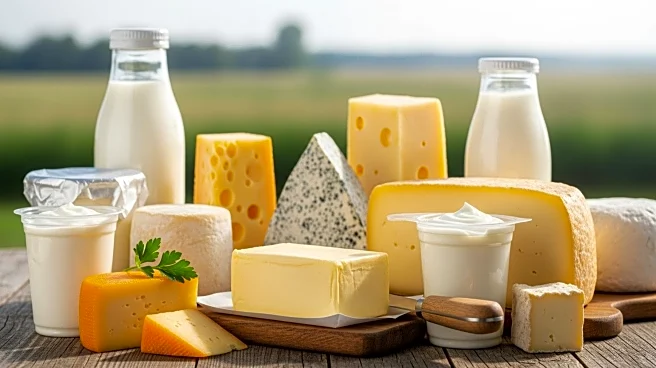What's Happening?
Dairy prices have been experiencing a mild but consistent decline over the past three months, according to the UN's Food and Agriculture Organisation (FAO). This trend is attributed to increased milk output across major exporting regions, including the US, EU, UK, New Zealand, and South America, which has led to an imbalance between supply and demand. Analysts Brittany Feyh and Jose Saiz from market intelligence company Expana note that the US national herd size is at its largest since the 1990s, contributing to the oversupply. Additionally, high farmgate prices, cheap feed, favorable weather conditions, and a decline in disease cases have allowed European milk production to rebound. Despite the decline, dairy prices remain approximately 9% higher than the previous year.
Why It's Important?
The decline in dairy prices has significant implications for the global dairy industry. While consumers may benefit from lower prices, producers face challenges due to the oversupply and reduced demand in certain sectors, such as hotels, restaurants, and catering. The US is capturing more global market share due to competitive pricing, which could impact international trade dynamics. The continued high production levels suggest that prices may remain low, affecting profitability for dairy farmers. This situation highlights the need for strategic adjustments in production and marketing to balance supply and demand effectively.
What's Next?
As farm milk prices remain profitable, analysts predict that milk production will continue to grow into 2026. This could further exacerbate the supply-demand imbalance unless demand increases or production is adjusted. The dairy industry may need to explore new markets or innovate product offerings to stimulate demand. Additionally, international competitiveness, particularly for European dairy products, may require strategic interventions to improve market positioning.
Beyond the Headlines
The current situation in the dairy market underscores the importance of monitoring global agricultural trends and adapting to changing conditions. The decline in dairy prices could lead to long-term shifts in production practices and international trade policies. Ethical considerations regarding sustainable farming practices and environmental impacts may also come to the forefront as the industry navigates these challenges.











